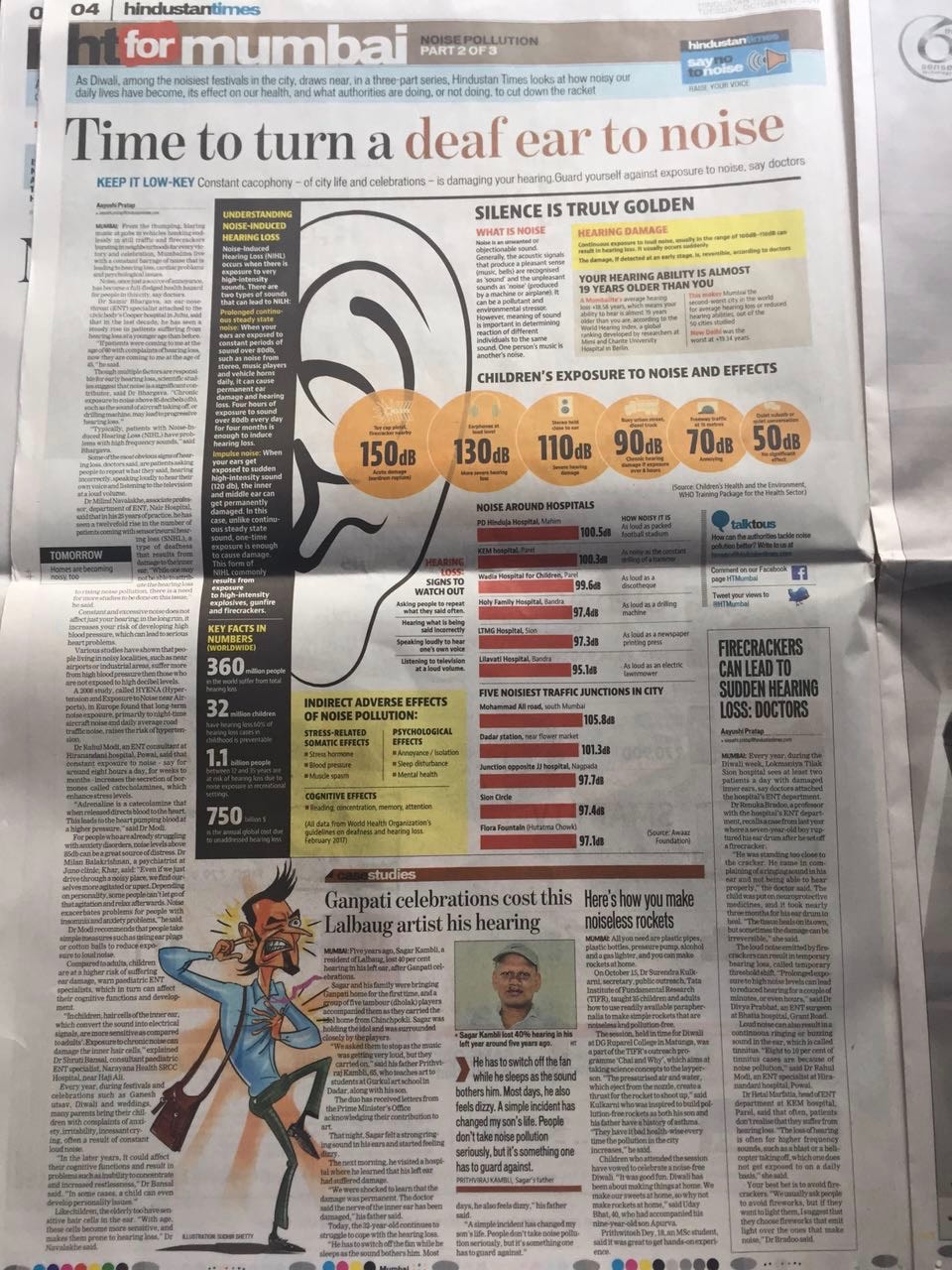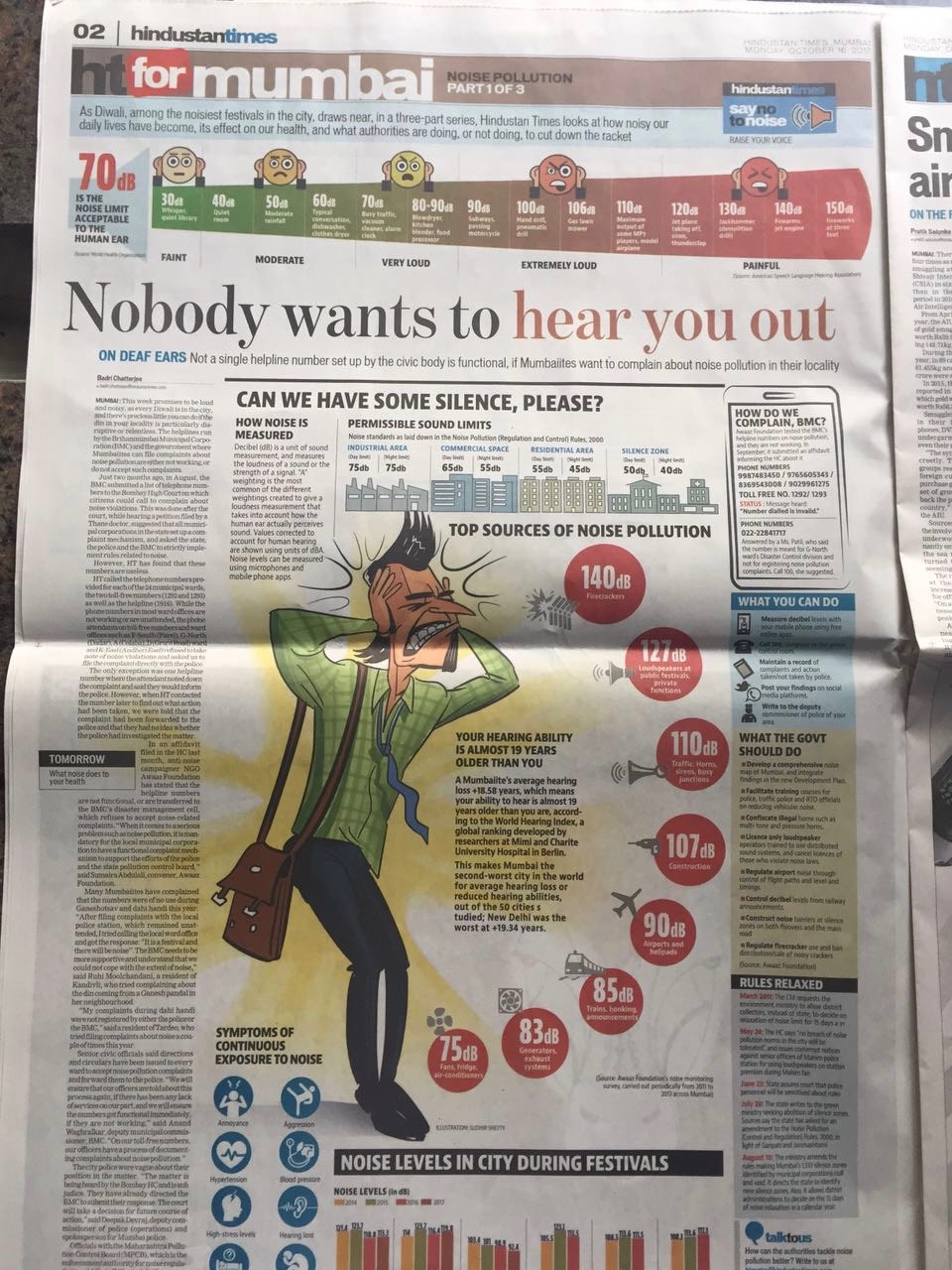|
0 Comments
Maharashtra: Tests show crackers exceed noise limits
While the single crackers were found to be within their permissible limits of 125 dB(A), with most measuring between 116 to 119 dB(A), they were still found to be higher than last year's highest reading of 117 dB(A). Written by Benita Chacko | Mumbai | Updated: October 5, 2017 8:43 am <img class="wp-image-2551572 size-full" src="http://images.indianexpress.com/2015/11/kurali-crackers-759.jpg" alt="firecrackers, diwali 2017, firecrackers pollution, firecrackers noise pollution, firecrackers air pollution, Maharashtra Pollution Control Board, Awaaz Foundation" /> “The smoke and dust pollution caused by all the crackers seem to be higher than last year,” read the report prepared by Awaaz Foundation. (Express Photo) A firecracker testing conducted by the Awaaz Foundation along with the Maharashtra Pollution Control Board (MPCB) has shown that the series crackers violated the prescribed noise-pollution limit of 105 dB(A), setting the stage for a noisy Diwali. “The prescribed noise limits for series crackers is 105 dB(A) and most exceeded this limit. Firecrackers like the 10,000 Lar, Ooh La! La! And Street Fighter measured 112.6, 107 and 109.9 dB(A) respectively,” said Suraiya Artes from the Awaaz Foundation. The MPCB will recommend to the Controller of Explosives that these firecrackers be banned. While the single crackers were found to be within their permissible limits of 125 dB(A), with most measuring between 116 to 119 dB(A), they were still found to be higher than last year’s highest reading of 117 dB(A). However, the sound levels touched the outer limits of the permissible levels of 145 dB(C). In scientific parlance dB(A) represents the average noise levels over a certain period of time and dB(C) represents the maximum peak noise levels reached. The noise levels for single crackers reached 144.5 dB(C). “The smoke and dust pollution caused by all the crackers seem to be higher than last year,” read the report prepared by Awaaz Foundation. Similar tests will be conducted all over Maharashtra by the MPCB and a comprehensive report will be prepared by October 12 and it will also be shared with the Controller of Explosives. MPCB will also test the crackers for chemical pollutants. “We will request Controller of Explosives to take the required action against these firecrackers. We will conduct similar tests across Maharashtra till October 12,” said Dr VM Mothgare, Joint Director (Air Pollution Control). Bombay high court raps Maharashtra govt’s silence on noise during dahi handi, Ganpati
The court noted the noise had crossed permissible levels during Ganpati, but no apparent action had been taken against the violators MUMBAI Updated: Sep 08, 2017 00:58 IST Kanchan Chaudhari Hindustan Times The bench also expressed displeasure over the fact that the government had not made available a dedicated telephone line for citizens to register noise-related complaints during dahi handi and Ganpati celebrations. The Bombay high court on Thursday directed the state government to submit the number of noise pollution complaints it received during the recent dahi handi and Ganpati festivals and what action was taken against the wrongdoers. Noting that noise had crossed permissible levels during Ganpati, but no apparent action had been taken against the violators, the division bench of justice Abhay Oka and justice Riyaz Chagla told government pleader Abhinandan Vagyani that now the time had come for him to frankly admit non-compliance of court orders. During the course of hearing on a bunch of public interest litigations concerning strict implementation of the Noise Pollution (Regulation and Control) Rules, 2000, the bench also expressed displeasure over the fact that the government had not made available a dedicated telephone line for citizens to register noise-related complaints. Advocate Rohaan Cama, who represented one of the petitioners — Aawaz Foundation — said most of the helpline numbers publicised by the government either did not exist or did not work, and the numbers that were working turned out to be telephone lines meant for some other purposes such as the disaster management cell of the Brihanmumbai Municipal Corporation (BMC). Vagyani, on the other hand, submitted it is not that authorities haven’t done anything. Although the state did not fully comply with court directions concerning noise pollution, “we have made sincere attempts to implement the court orders.” The court has now posted the bunch of petitions for further hearing on September 29, with a direction to the government pleader to file by September 27 an affidavit giving details of the noise pollution complaints received during the festivals and action taken against the wrongdoers. Sep 07 2017 : The Times of India (Mumbai)
How loud was final immersion day? There's no clear answer Mumbai: TIMES NEWS NETWORK NGO And MPCB Record Varying Noise Levels On the final day of Ganeshotsav , the city recorded peak noise levels of 119.8 decibels (dB) at Santacruz, the second highest in four years, according to the readings done by NGO, Awaaz Foundation. Meanwhile, the Maharashtra Pollution Control Board (MPCB)'s readings showed the city fared better than last year on the last day considering average levels. Awaaz Foundation measured noise levels in various parts of the city on the last day of immersion. The highest levels recorded are 123.7dB in 2015. This year's highest levels were recorded opposite Santacruz police station. “While levels dropped last year, this year was the opposite.There was extensive use of noisy firecrackers for prolonged periods of time on the roads in Bandra, Santacruz, Vile Parle, Mahim, Dadar, Cuffe Parade and along the immersion route toward Girgaum Chowpatty .Last-minute changes in noise rules created a lot of confusion in implementation,“ said Sumaira Abdulali, convener of the foundation. Noise levels at Badamwadi in Kalbadevi were the second highest at 116.7dB. The lowest noise levels of 87dB were recorded at Gokhale Road, Dadar. According to the Noise Pollution (Regulation and Control) Rules, 2000, the maximum noise level in residential areas should not exceed 55dB in the day and 45dB at night. On the other hand, MPCB, which records noise levels at 25 locations in Mumbai, found that the average levels were lower compared to 2016. According to MPCB's readings, this year's highest average noise levels of 83dB were recorded at Dadar, lower than Chembur (east) which recorded 89.9 dB in 2016. “It was comparatively quieter this year because the use of DJ set-ups was low. People are more aware and that is showing results,“ said V M Motghare, joint director, MPCB. The MPCB measures continuous comprehensive noise at the locations between 6 am and midnight. Average levels across the state were between 60-95dB with Pune being one of the noisiest cities. A detailed report will be submitted to the Bombay high court. Brihanmumbai Sarvajanik Ganeshotsav Samanvay Samiti, the umbrella body of Ganesh mandals, claimed the use of DJs had dropped by 90%. Abdulali said while the average levels could be lower, peak levels continue to trouble citizens. “While there was reduced use of DJs, brass bands and drums were seen throughout the city. Metal cylinders beaten with hammers, which were used extensively in the suburbs and sporadically in south Mumbai created the highest noise levels, exceeding last year's maximum noise levels,“ she said. |
Noise PollutionAwaaz Foundation's anti- noise pollution campaign has been covered extensively in the Press and media since 2003. Archives
September 2022
Categories
|
- Welcome
- Noise Pollution
- Sand Mining
-
Other Projects
- Climate Change >
- Air Pollution >
- Firecrackers >
- Stone quarrying or recycling debris >
- Alibag Solid Waste Management >
- Climate Change News
- Sawantwadi-Dodamarg Wildlife Corridor >
- MITRA (Movement against Intimidation, Threat and Violence against Activists) >
- Eco friendly Festivals >
- Light Pollution >
- Oil Spills >
- Coastal Road and Development Plan >
- Urban Trees >
- Anti Smoking >
- Miscellaneous News
-
#AWAAZFORACTION
- About



 RSS Feed
RSS Feed
